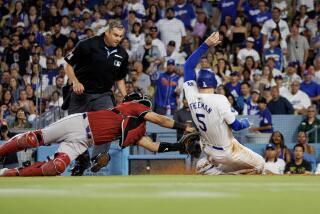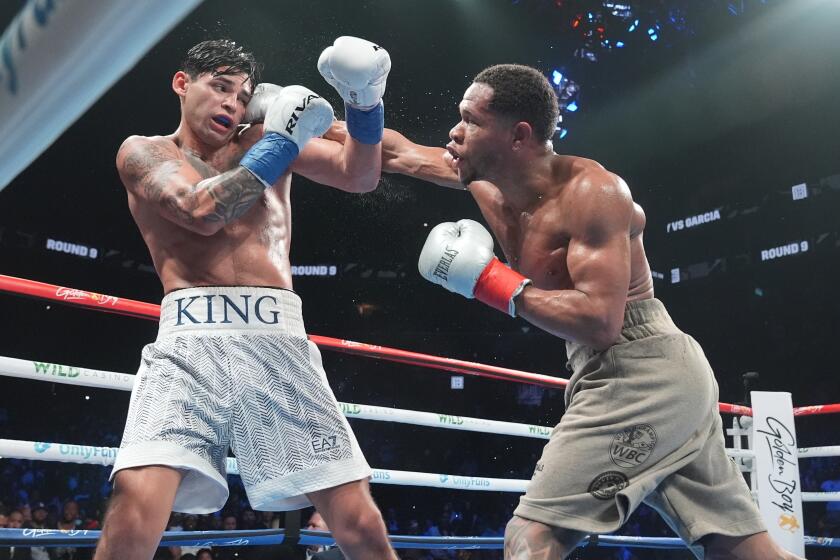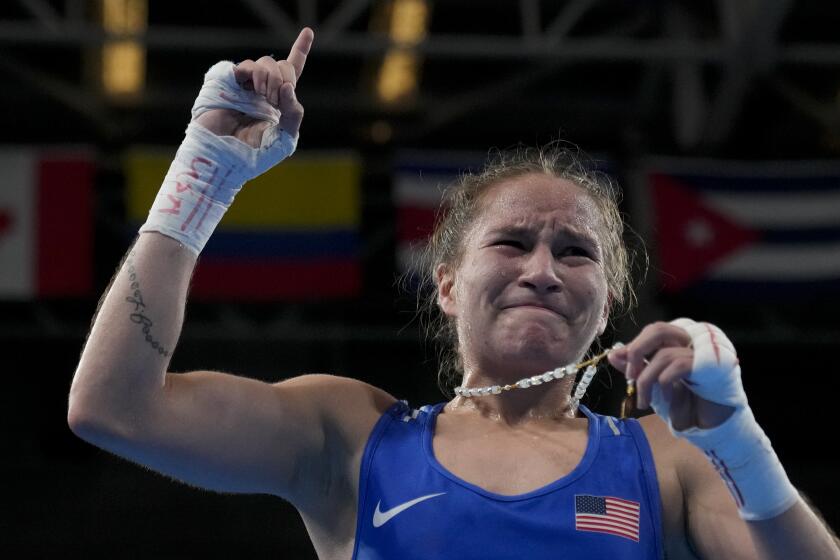Willard Victory Recalled : On April 5, 1915, He Knocked Out Jack Johnson at Cuban Track
Eighty years ago Wednesday, after seven years of yearning, white America finally got its Great White Hope.
On April 5, 1915, in a prize ring built on a Cuban racetrack, a Kansas cowboy named Jess Willard knocked out the first world-famous black athlete, Jack Johnson.
In the history of boxing’s heavyweight title fights, the setting and circumstances for Willard-Johnson remain one of the oddest.
Johnson, 37, the champion, was on the lam, a man without a country. Sentenced to federal prison in 1913 on a trumped-up violation of the Mann Act, Johnson had fled the United States for Europe.
Willard, 33, was a giant of his day. At 6-feet-6 1/4 he ranks as the tallest heavyweight champion. And in his black cowboy hat and boots, he looked 7 feet.
Since July 4, 1910, promoters had scoured the country, looking for something they called “the Great White Hope.” On that date, in Reno, Johnson had shocked white America by easily beating former champion Jim Jeffries, sparking race riots in nearly every major city in America.
Racism was rampant in the first decades of the 20th Century. Black men were expected to defer to whites. And, above all, a black man was never to look at a white woman, much less marry one.
But Jack Johnson wasn’t an ordinary man. He married three white women.
When he won the title in 1908 in Australia by beating a white champion, Tommy Burns, writers--most prominently Jack London--sent up a call for a Great White Hope.
Jeffries, who had retired in 1905 and was fat--320 pounds--and happy on his Burbank alfalfa farm, was persuaded to answer the call.
They called it “the fight of the century.” That was before the fight. Johnson not only won easily, he laughed defiantly at both Jeffries and the fuming, mostly white crowd.
On July 4, 1910, Jess Willard drove a six-team wagon into Oklahoma City and found the citizens there in an uproar over Jeffries’ defeat.
Later, when someone saw the 250-pound Willard hoisting bales of hay onto his wagon, someone remarked that he was perhaps the man to beat Johnson.
Soon afterward, at the Olympic Athletic Club in Oklahoma City, at 28, he pulled on boxing gloves for the first time.
Willard was a true-to-life cowboy. As a teen growing up on a farm in Pottawatomie County, Kan.--they would later call him “the Pottawatomie Giant”--he broke wild horses he had caught.
His boxing career began in undistinguished fashion. He lost his first match, on a foul, in February, 1911.
He then won seven in a row before suffering a knockout loss. In early 1913, he lost an important match to top contender Gunboat Smith in San Francisco. He lost again in Youngstown, Ohio, in March, 1913.
He won two more and somehow, with four losses in 30 fights, he was offered a fight with Johnson.
While the slow, ponderous Willard was learning to box, white hatred toward Johnson reached its peak. On Dec. 4, 1912, he married his third white wife, Lucille Cameron.
This was after the U.S. Attorney in Chicago had charged him with a Mann Act violation, or transporting a female across state lines for immoral purposes.
Later, in a trial, it would come out that Cameron not only had never traveled outside Illinois with Johnson but she refused to testify against him.
Seeing they needed another Mann Act violation, the feds combed Johnson’s past and found one: Belle Schreiber, another white woman. Once jilted by Johnson, Schreiber eagerly testified for the government.
Johnson’s attorney, however, pointed out this had occurred before the Mann Act went into effect, in 1910.
Nevertheless, the all-white grand jury bought the government’s flimsy case and indicted him. The judge, Kenesaw Mountain Landis (later commissioner of baseball), issued an arrest warrant.
In June, 1913, he was sentenced to a year and a day in federal prison and fined $1,000. He was granted two weeks to file an appeal.
In Chicago, Johnson bought railway and steamship tickets through Montreal to La Havre, France. He slipped out of Chicago at night, disguised as a member of a Canada-bound black baseball team.
When it was learned he was in Canada, on his way to France, the Canadians wouldn’t extradite him because he had entered Canada with through-passage to France.
Johnson spent the next two years in Europe (Paris, mostly) and South America. He won two title defenses in Paris and fought exhibitions in Buenos Aires.
By 1915, he was broke, the $110,500 he’d earned for the Jeffries fight long gone, spent on champagne, women and fast cars.
Promoter Jack Curley arranged a big-money Johnson defense against Willard, then sought a foreign site Americans could reach easily. Johnson was still a U.S. fugitive.
He first settled on Juarez, Mexico.
But problems arose, first with Mexican rebel Pancho Villa, who wanted a cut of the action. And Johnson feared he’d be kidnaped by Villa while traveling to Juarez and held for ransom for Curley, or worse, the American government.
Havana beckoned. Curley moved his fight to the Oriental Park Race Track, 12 miles from downtown Havana. A ring was built on the track itself. Thousands of American fight buffs arrived by steamship from New Orleans and Key West.
Tickets were priced from $25 to $3--staggering sums then, for pre-World War I America.
Los Angeles, in April, 1915:
--In the Westlake/Wilshire district, a 121-room apartment complex----with an all-mahogany billiard parlor----was on the market for $175,000.
--The latest Mary Pickford flick, “The Darling of the Movies,” was playing at the Woodley Theater, Broadway at Ninth. Admission: A dime for downstairs, 25 cents for a loge seat.
--Silverwood’s, 331 So. Spring, was selling Hart Schaffner & Marx Suits for $25.
--A can of Campbell’s soup was a dime.
--Round trip steamship fare to Honolulu was $110.
No Willard-Johnson crowd count was announced that day, but the fight film indicates a crowd of perhaps 15,000, with thousands more gathered on a distant hillside.
Johnson, who weighed 212 when he beat Jeffries nearly five years previous, was now 37 and 225 pounds. Willard, 34, was a lean 238.
Johnson was a thin betting favorite, and for the first 15 rounds it seemed Willard, like Jeffries, would fail. The very sharp film shows both men doing a lot of flat-footed posing, hands at their waists, but with Johnson most often the aggressor.
For decades afterward, Johnson would claim he took a dive in the fight, that his wife, seated at ringside, was given a satchel containing $50,000 in $500 bills.
The alleged payoff, Johnson claimed, was part of a promise for a lenient or no sentence for his Mann Act indictment. The Feds later double-crossed him, he claimed.
Most boxing historians discount the claim, the fight film itself being their most persuasive argument.
Johnson, in the first 15 rounds, launches numerous furious assaults at Willard, who backs off each time, covers up, seemingly employing a waiting strategy, waiting for Johnson to tire.
In the 20th, a Willard right hand at close range hurts Johnson, and the film viewer sees the crowd rise to its feet and wave straw hats. In the 25th, Willard suddenly becomes very aggressive, leaning on and pushing an exhausted Johnson.
The crowd, sensing the end of Johnson’s seven-year reign is at hand, rises and cheers.
In the 26th, in the challenger’s corner, Willard lunges at the champion and lands a right flush on his face. Johnson crumples to the canvas, and tries to grab Willard as he falls.
He lands on his back, where he’s counted out.
Those who later claimed Johnson took a dive point to the famous photo of him being counted out, with his forearms over his eyes, seemingly shielding his eyes from the bright sun.
But he remains on his back well after being counted out and he’s seen being hauled to his feet by handlers. If he intended to go in the tank, whey did he wait 26 rounds on a 103-degree day?
Whatever, Johnson earned $30,000, a sum he spent in about a year.
Willard, whose purse went unreported at the time, had earlier foolishly signed pieces of himself away to a syndicate. He said later his “managers” took 75% of his purse.
However, once shed of parasites, Jack Johnson’s conqueror quickly became the richest American athlete in history.
Upon arriving by ship in Key West the next day, he was accorded a hero’s welcome. On his way to New York, thousands cheered him at stops along his way.
Within a week, he was earning $5,000 per week at New York’s Hammerstein’s Victoria Theater, talking to audiences about the fight and staging boxing workouts and pantomimes.
Later, he joined Buffalo Bill’s Wild West Show and appeared with famed fellow cowboy Tom Mix. In one stretch, he performed in 188 shows in 32 weeks in 23 states.
By early 1917, he said, he’d made between $600,000 and $700,000, since the Havana fight.
By 1927, Willard’s real estate holdings alone were worth about $750,000, according to his grandson, Jim Mace. Mace wrote a never-published 131,000-word manuscript about Willard’s life. It’s owned today by the Paul Ziffren Sports Resource Center in Los Angeles.
Willard lost his fortune in the Depression. Hauled into a Los Angeles court in 1932 for writing a $120 check with insufficient funds, Willard told a judge he owned no property and had no money.
He remains almost a tragic figure in boxing’s history. It was his fate for his heavyweight reign to be framed by the more famed eras of Jack Johnson and Jack Dempsey.
In Toledo, Ohio, in 1919, Dempsey nearly killed Willard when he took Willard’s championship. He turned The Great White Hope into a great white heap.
Bitter, Willard spent the rest of his life claiming Dempsey used loaded gloves that day, a charge Dempsey vehemently denied.
Willard, who lived in the Los Angeles area most of his life, was a resident of Sunland and La Crescenta in his last years.
He died at 87 on Dec. 15, 1968, of a heart attack. He’s buried at Forest Lawn Hollywood Hills, on a grassy slope overlooking Disney Studios and the San Gabriel Mountains.
Jack Johnson, who surrendered to federal authorities at Tijuana in 1920, served his year-and-a-day sentence at Leavenworth, Kan. Afterward, he lived a relatively quiet life.
He died in an auto accident on June 10, 1946, near Raleigh, N.C. A notoriously reckless driver, Johnson, 68, was driving to the Joe Louis-Billy Conn fight in New York.
In Chicago, his funeral was attended by thousands.
He was buried in Graceland Cemetery, beside his first wife.
More to Read
Get our high school sports newsletter
Prep Rally is devoted to the SoCal high school sports experience, bringing you scores, stories and a behind-the-scenes look at what makes prep sports so popular.
You may occasionally receive promotional content from the Los Angeles Times.






